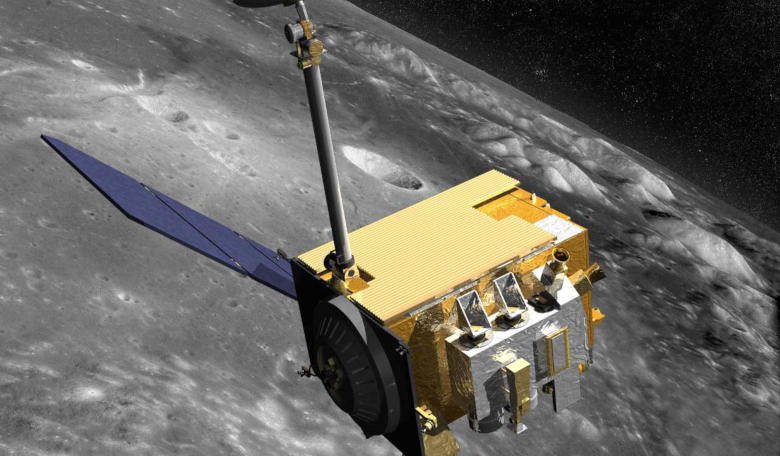With potential lunar prospectors lining up to mine the Moon, a new study by scientists using the Miniature Radio Frequency (Mini-RF) instrument on NASA's Lunar Reconnaissance Orbiter (LRO) spacecraft will be a welcome delight, as data reveals that the Moon's subsurface might be richer in metals, like iron and titanium, than researchers previously thought.
The origin of the Moon has been the subject of much debate for decades now, though many scientists agree that it likely evolved after a Mars-sized object crashed into Earth leaving behind a trail of debris that coalesced to form our nearest celestial neighbour.
This scenario stacks up well when you compare the bulk chemical composition of both the Earth and Moon as the two are very similar.
Or at least, that appears to be the case. However continued research into the Moon’s chemical composition is revealing a changing perspective.
If Earth had fully differentiated into a core, mantle and crust before the impact, the Moon would be largely metal-poor.
This evidence is seen in the rocks of the lunar highlands, which contain smaller amounts of metal-bearing minerals relative to our planet.
But, if you then look at the metal abundance of rocks in the Moon's maria - the large, darker plains - this theory is turned on its head because they are richer in metals than many rocks on Earth.
This disparity in data just doesn’t add up and as such it has led to many different hypotheses, each explaining how the impacting object may have contributed to the differences.
Now though, a team of scientists who were originally hunting for ice hidden in polar lunar craters say they have stumbled across evidence to clear up the confusion regarding the Moon’s formation.
The researchers, headed by Essam Heggy at the University of Southern California, had been using the Mini-RF instrument to measure an electrical property within lunar soil in crater floors in the Moon's northern hemisphere.
This electrical property is known as the dielectric constant, a number that compares the relative abilities of a material and the vacuum of space to transmit electric fields.
Although the team were using it to help locate ice lurking in the crater shadows, they noticed this property increasing with crater size.
For smaller craters approximately 2 to 5 kilometers (1 to 3 miles ) wide, the dielectric constant of the material steadily increased as the craters grew larger.
For larger craters 5 to 20 kilometers (3 to 12 miles) wide though, the property remained constant.
"It was a surprising relationship that we had no reason to believe would exist," says Heggy, who is coinvestigator of the Mini-RF experiments.
The discovery led to the realisation that meteors that form larger craters also carve out more of the surface material, which in turn exposes more of the elements that lie beneath.
As dielectric properties are directly linked to the concentration of these metal minerals, it would account for why the team were recording an increasing dielectric constant of dust in larger craters - because they had more metal in them.
To back up this hypothesis, metal oxide maps from the LRO Wide-Angle Camera, Japan's Kaguya mission and NASA's Lunar Prospector spacecraft were compared with crater floor radar images from Mini-RF.
The results confirmed what the team suspected; more iron and titanium oxides had been excavated from the depths of 0.5 to 2 kilometers (0.3 to 1 mile) than from the upper 0.2 to 0.5 kilometers (0.1 to 0.3 miles) of the lunar subsurface in larger craters.
"This exciting result from Mini-RF shows that even after 11 years in operation at the Moon, we are still making new discoveries about the ancient history of our nearest neighbour," said Noah Petro, the LRO project scientist at NASA's Goddard Space Flight Center in Greenbelt, Maryland.
"The MINI-RF data is incredibly valuable for telling us about the properties of the lunar surface, but we use that data to infer what was happening over 4.5 billion years ago!"
These new results, recently published in Earth and Planetary Science Letters, are inline with evidence from NASA's Gravity Recovery and Interior Laboratory (GRAIL) mission which found an anomalous and significant mass of dense material beneath the Moon's huge South Pole-Aitken basin.
The mysterious mass which is presumed to be metallic in nature and is five times larger than the Big Island of Hawai, indicates that dense materials aren't uniformly distributed in the Moon's subsurface.
Despite the new results, the team are keen to point out that the study can't directly answer all of the outstanding questions about the Moon's formation, but it does reduce the uncertainty in the distribution of iron and titanium oxides in the lunar subsurface.
"It really raises the question of what this means for our previous formation hypotheses," Heggy said.
In a bid to draw a clearer connection between Earth and the Moon, the researchers have already started examining crater floors in the Moon's southern hemisphere to see if the same trends exist there.











